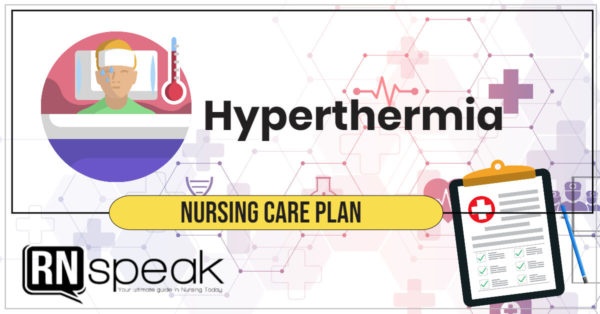Hyperthermia or commonly known as fever is present when the body temperature is higher than 37ᴼC which can be measured orally, but 37.7ᴼC if measured per rectum. Due to recent events, acquiring contactless temperature is advised using infrared temperature taking devices such as Thermoscan or Thermoflash.
It occurs when the body is invaded by some bacteria, viruses, or parasites. Sometimes the occurrence of fever may also be due to non- infectious factors like injury, heat stroke or dehydration. Some medication also causes drug-induced hyperthermia such as Ephedrine, Sulfa Drugs, Interferons, etc.
Some underlying conditions can also cause hyperthermia, like thyrotoxicosis, heart attack and other forms of cancer. If not treated properly, a client may be at risk for its complications involving febrile convulsions, happening mostly to pediatric clients aging from 6 months to 6 years of age, and brain damage; which could be because of prolonged and repeated febrile convulsions.
In a video posted by Alila Medica lMedia, a simplified explanation of the physiology of temperature control was discussed. They also mentioned in the said video the different causes of hyperthermia as mention previously in this article.
Drugs Causing Hyperthermia
- Antibiotics – These drugs are specifically made to treat bacterial infections. There are many different classes of antibiotics but beta-lactam and sulfonamide antibiotics are more likely to result in a raised body temperature.
- Isoniazid
- Anti-arrhythmia Drugs -These are drugs that are used to treat an abnormal rhythm of heart muscle contractions.
- Procainamide
- Quinidine
- Anti-epileptic Drugs – These drugs are used to prevent seizures in epilepsy and are also known as an anticonvulsant.
- Phenytoin (diphenylhydantoin)
- Carbamazepine – may also be used for trigeminal neuralgia and bipolar disorder.
- Anti-hypertensive Drugs – These drugs are used to treat high blood pressure (hypertension).
- Alpha-methyldopa
- Anti-fungal Drugs – These drugs are used to treat fungal infections.
- Amphotericin B
- Ephedrine
- Sulfa Drugs
- Interferons
- Narcotics/Illicit Drugs – An increase in body temperature may depend on the quantity of the drug used.
- Amphetamines
- MDMA (ecstasy)
- Cocaine
- Cannabis (marijuana)
- Phencyclidine (PCP)
Factors that affect body temperature
- Age – The change in body temperature is commonly noted in children and elderly people. Due to the high metabolic rate of children, it is safe to say that on average, kids have a higher baseline body temperature than adults. On the other hand, it is also true that older people (more than 65 years old) tend to have a lower body temperature than younger adults. It is progressive as age increases. Lower body temperature can disrupt their immune responses, which could cause various infections.
- Sex – In 1868, German physician Carl Wunderlich claimed in his study that women are most likely to have higher body temperature than men. But in 1993, Wunderlich’s theory was disapproved as it was found through a study that there is no significant difference in male and female body temperature. However, there are instances where women’s temperature increase such as during ovulation and pregnancy and lower at the start of the menstrual cycle.
- Time of The Day – A significant fluctuation in the body temperature is noted during the course of a day. It is usually low in the morning and slowly rises during the duration of the day reaching its peak during the afternoon.
- Exercise or Physical Exertion – In order for muscles to function they need energy. During the process strenuous physical energy is exerted allowing the muscles to generate a great amount of heat, which leads to increased body temperature.
- Stress – During a stressful situation the body temperature also increases. Hormones such as cortisol and adrenaline cause this body temperature reaction. It is an adaptive response of the body when dealing with potential or perceived threats.
- Meals – One’s body temperature can also be slightly altered shortly after food consumption. This is because there is an increase in your client/patient metabolic rate.
- Drugs and Smoking – As mentioned above, there are some medications that can contribute to the body’s thermal regulation. Spikes in temperature were also recorded during smoking.
Fever Nursing Care Plan
Nursing Diagnosis: Hyperthermia
Possible Etiologies: (Related to)
- Exposure to an environment with increased temperature; inappropriate clothing
- Dehydration; extreme activity
- Inability or decreased ability to perspire
- Illness or trauma
- Intake of medication; post -anesthesia effect
- Increased metabolic rate
- Direct effect of circulating endotoxins on hypothalamus resulting to an altered temperature regulation
Defining Characteristics: (Evidenced by)
Subjective Data:
“I am not feeling well right now. My head is aching and burning as if the steam comes out of my ears periodically.”
Objective Data:
- Flushed skin with a body temperature of 38.1ᴼC per axilla
- Respiratory rate of : 21 breaths per minute
- Pulse rate of: 89 beats per minute
- Unstable blood pressure
- Muscle rigidity; chills
- Profuse diaphoresis
Objectives:
Short term goal:
Client will be able to resume and maintain normal body temperature after 4 hours.
Long term goal:
Client will be free from complications such as irreversible brain or neurologic damage.
Outcome Criteria:
Client will be able to report and show manifestations that fever is relieved or controlled through verbatim, temperature of 36.8ᴼC per axilla, respiratory rate of 12- 18 breaths per minute, pulse rate of 60- 75 beats per minute, stable blood pressure, absence of muscular rigidity/ chills and profuse diaphoresis after 4 hours of nursing care.
Client will be free from febrile convulsions resulting to brain damage after 1 week of nursing care.
See Also
- Typhoid Fever Nursing Management
- Dengue Hemorrhagic Fever and its Nursing Management
- Dengue Fever Nursing Care Plan-High Risk for Fluid Volume Deficit
- Dengue (Dengue Hemorrhagic Fever) Pathophysiology & Schematic Diagram
Nursing Interventions:
| Nursing Actions | Rationale |
| Assess and monitor client’s temperature and note for presence of chills/ profuse diaphoresis; also note for degree and pattern of occurrence. | – Temperature 38.9ᴼC – 41ᴼC may suggest acute infectious disease process. A sustained fever may be due to pneumonia or typhoid fever while a remittent fever may be due to pulmonary infections; and an intermittent fever may be caused by sepsis or tuberculosis. |
| Adjust and monitor environmental factors like room temperature and bed linens as indicated. | -Room temperature may be accustomed to near normal body temperature and blankets and linens may be adjusted as indicated to regulate temperature of client. |
| Apply tepid sponge bath sponge bath. See link for demo:Giving a Patient a Bed Bath | – It could help in reducing hyperthermia; avoid using alcohol and iced water which may even produce chills and increase client’s temperature. |
| Administer antipyretics as prescribed by the physician, utilizing the 10 Rs in giving medication. | – Antipyretics acts on the hypothalamus, reducing hyperthermia. |
| Provide a cooling blanket as indicated. | – It It helps reduce increased body temperature especially with temperatures of 39.5ᴼC – 40ᴼC. |
| Encourage the client to increase fluid intake. | – Water regulates body temperature. |
| Raise the side rails at all times. | – To ensure the client’s safety even without the presence of seizure activity. |
| Start intravenous normal saline solutions or as indicated. | -To replenish fluid losses during shivering chills. |
| Provide a high caloric diet or as indicated by the physician. | -To meet the metabolic demand of the client. |
| Educate client of signs and symptoms of hyperthermia and help him identify factors related to the occurrence of fever; discuss the importance of increased fluid intake to avoid dehydration. | – Providing health teachings to client could help client cope with disease condition and could help prevent further complications of hyperthermia |













Drug study for thrombophlebitis